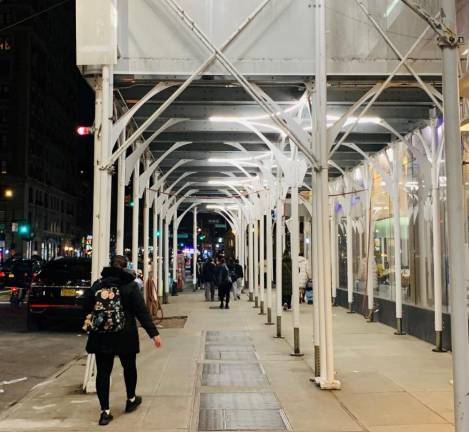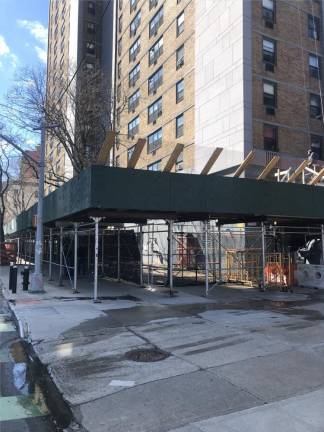Reach for the Sky: New Scaffold Bills Call for 50% Boost in Height and New LED Lighting
New bills being proposed by four Manhattan city council members call for eliminating dark and foreboding sheds by boosting the height requirement to 12 ft and using brighter LED lighting to ward off the darkness. Scaffolds around parks and playgrounds would face even stricter regulations.


New bills to overhaul scaffolds that now cover 280 miles of sidewalks in New York City would force builders to make them taller, take them down faster, and illuminate them more brightly while they are standing.
Sheds near parks and playgrounds would have even stricter regulations, pushing the proposed height of a shed even higher.
Four Manhattan Council Members, led by Majority Leader Keith Powers, put forth a package of legislation in sync with the “Shed the Shed” report issued earlier this month by Manhattan Borough President Mark Levine. Joining Powers in a joint press conference March 16 to unveil the new bills were council members Erik Bottcher who represents Chelsea and Hell’s Kitchen, Chris Marte who represents downtown Manhattan and Shaun Abreu, who represents the upper west side including Morningside Heights, west Harlem, and Washington Heights.
No surprise that the four sponsors all come from Manhattan, which has more than twice as many sheds as any other borough, with 4,000 of the 9,000 citywide located on the island.
Scaffolds have the been the source of complaints for years, from being used by bar patrons using them as a place to relieve themselves late at night, to being the subject of vandalism, robberies and other crimes. One shed was the scene of a rape in Chelsea last December.
”We have not recovered from the pandemic,” said Councilman Bottcher at the press conference, “and one of the things that are holding us back are these quality of life issues.” He said there are over 280 miles of scaffolding over sidewalks in New York City currently. “No other city around the world has this problem.”
The scaffolding laws that are in effect now, date back to the time when illumination came from incandescent light bulbs, Bottcher said. “Today we have LED lighting, LED strips that are far brighter,” he said. “We’re going to up the lumens.”
“Sidewalk sheds play an important role in keeping New Yorkers safe from falling debris and equipment on New York City streets,” said Borough President Levine in issuing the “Shed the Shed” report earlier this month. “But across the city, these sheds, built to comply with local law inspection and repair requirements, are too often left up for months, or even years. Over 230 scaffoldings across the city have been up for over five years.”
Here’s a look at the package of new bills, introduced by Powers and allies overhauling some of the regulations which date back to 1885, and which have key provisions that even building owners will be happy to see.
Introduction 970 establishes new design requirements for scaffolding, allowing the structures to be painted in several different colors and raises the minimum height to 12 feet–up from the current eight feet–as well as creating less expensive alternatives to scaffolding. Building owners are likely to applaud the later plank
Introduction 972 fixes timelines for scaffolding removal should no active construction take place over an extended period of time. Regulations covering a hike in the fine for being delinquent in making repairs is still being worked out with the building department, but the bill is designed to penalize builders who put up scaffold due to a structural problem, and then opt to pay the current fine of $5,000 every six months rather than spend many times that amount to actually make the required repairs. The new bill would allow the Building Department to yank a building permit and then allow the City to step in and correct unsafe conditions–and then bill the property owner for the work.
Introduction 452 allows the City to establish a pilot drone program for the inspection of building facings, which if passed into law might help work off the backlog on work that is completed but needs a city inspection before it can be taken down. Anything that speeds up building department inspections will likely draw support from owners.
Introduction 971 protects tree cover, requiring any trees that are damaged or removed when setting up equipment to be repaired or replaced within 6 months.
Other new regulations that Powers and Bottcher, Marte and Abreu introduced include:
Introduction 973 allows for newly constructed buildings to have their first facade examination take place in 8 years rather than the current 5 since they use safer materials. It would require the Building Department to coordinate inspections on the same block so facade repairs happen simultaneously. Building owners are likely to applaud this since a big complaint from property owners is that there are too many onerous and time consuming regulations from the notoriously slow moving building department.
City Council Member Marte is also introducing a bill as part of this package:
Intro 966 requires the Department of Buildings to inspect scaffolding every six months and issue an administrative fee per inspection.
Councilman Bottcher added these to the mix:
Intro. 954 This legislation will establish heightened design standards for scaffolding that is obstructing public amenities like parks and playgrounds. He cited one scaffold that has been up around a new basketball court in Matthew Palmer Park in Hell’s Kitchen as an example.
Intro. 955 provides for better lighting under the scaffolding, replacing outdated lighting technology with new LED lighting strips and for a uniform light level to be present throughout a shed.
Intro. 956 specifies a time limit of six month for pulling permits to do work after scaffolding is erected. Property owners must apply for work permits within that time, if not, they will be subject to fines.
While the politicians played up the quality of life issues for the people, Ryan Monell VP of Government Affairs for the Real Estate Board of New York is tenatively supportive of some of the changes as well. “REBNY agrees on the value of updating scaffold policies to help improve quality of life and retail leasing opportunities. We look forward to working together on this important issue.”
During Thursday’s press conference, Councilman Marte quipped “The one thing in New York City that defies gravity is scaffolding. It goes up, but never comes down.”
He then noted, “This will change the history of New York.”
The oldest current scaffolding in the city dates back to 2006. And even the Building Department had a scaffolding up around its HQ for eleven years, before it was finally taken down in 2019.